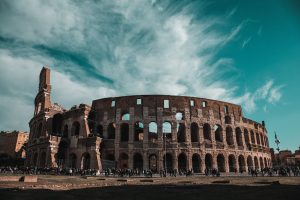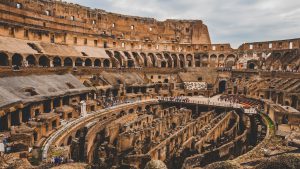Colosseum
A testament to the majesty of a bygone era, the Colosseum stands in the heart of Rome, where the whispers of ancient history mingle with the pulse of modern life.
An architectural marvel that has withstood the test of time, this iconic amphitheater resonates with the echoes of gladiator battles, epic dramas, and the collective heartbeat of a civilization that once thrived within the embrace of its colossal walls.
Introduction
The Colosseum in Rome is a symbol of endurance, majesty, and the everlasting fascination of history when it comes to famous landmarks that have weathered the test of time.
Millions of people from all over the world continue to be enthralled by this historic amphitheater because of its fascinating history, stunning architecture, and cultural relevance. To discover the Colosseum’s enduring appeal, we set out on a historical journey in this piece.
A Monumental Marvel of Ancient Rome
With a seating capacity of more than 50,000 people, the Colosseum, often referred to as the Flavian Amphitheatre, is the biggest amphitheater ever constructed.
This enormous arena, which was built in the first century AD, has stood as a tribute to Roman engineering and construction for almost two millennia.
Its elliptical layout, which spans an astonishing 6 acres, exemplifies the skill of Roman architects and builders who built a building of previously unheard-of magnitude and elegance.
A Look at Gladiatorial Battle
Gladiatorial conflict is one of the most memorable images connected to the Colosseum. The arena served as the setting for innumerable dramatic fights between gladiators, who occasionally even engaged in animal combat.
The main attraction of Roman entertainment, drawing both locals and visitors, was these terrible competitions. In the past, gladiators and animals were kept in the tunnels and underground chambers that may now be explored by tourists.
Cultural Importance
Beyond serving as a battlefield, the Colosseum has significant historical value.
It has hosted a variety of activities, including chariot racing, theatrical reenactments of historic conflicts, and mock sea warfare.
This magnificent amphitheater served as a venue for social gatherings and creative expression, fostering a thriving cultural center in the center of ancient Rome.
The Colosseum’s Survival Over Time
The Colosseum remains tall in Rome today despite having endured centuries of neglect, natural disasters, and even stone theft. Its incredible fortitude and endurance are proof of the renowned building’s everlasting attractiveness.
The Colosseum of Today
Today’s Colosseum visit offers a singular fusion of architectural wonder, culture, and history. You may stroll through the hallways where Roman citizens once shouted for their favorite gladiators and reveled in the show during a tour of this iconic location.
The Colosseum is one of the New Seven Wonders of the World and is now a UNESCO World Heritage Site.
A Sign of the Might and Ingenuity of the Romans
Emperor Vespasian of the Flavian dynasty gave the Colosseum its order, and his son Titus finished building it in 80 AD.
A huge arena where the populace might be amused and awed, it functioned as a symbol of Rome’s strength and domination. Rome was declared to be the center of the civilized world by its splendor, which served as a symbol of the city’s power.
The Colosseum was built using ground-breaking methods for the time, which are still outstanding examples of architecture today. These methods included the use of concrete and a sophisticated network of passages and elevators.
Pop Culture’s Use of the Colosseum
The Colosseum’s iconic stature extends beyond its historical significance and enters popular culture and the arts. This beautiful building has appeared in several motion pictures, including Ridley Scott’s “Gladiator,” where it played a crucial role in the story.
Over the years, it has captured the imagination of innumerable authors, poets, and artists, serving as both a source of strength and a metaphor for resiliency.
The Colosseum is a living icon that continues to inspire people around the world, not just a historical artifact.
Preservation and restoration
It has experienced its share of difficulties throughout the ages. It weathered earthquakes, fires, and stone theft for use in other construction projects.
However, extensive preservation and restoration initiatives have been implemented to guarantee that this spectacular structure will last for many more centuries.
It is currently undergoing restoration efforts to shield it from the effects of pollution, weathering, and erosion and preserve its beauty and history for the benefit of future generations.
Conclusion:
Travelers have long had a special place in their hearts for the Colosseum, an enduring icon of Rome’s grandeur and tenacity.
This old amphitheater is still a tribute to human inventiveness and the appeal of history, both for its historical relevance and its magnificent architecture.
A trip to the Colosseum is more than simply a trip down memory lane; it also provides a window into the splendor of a culture that helped to create the modern world.
You can’t help but feel the weight of centuries of history and Rome’s lasting influence as you stand in the shadow of this famous building.

